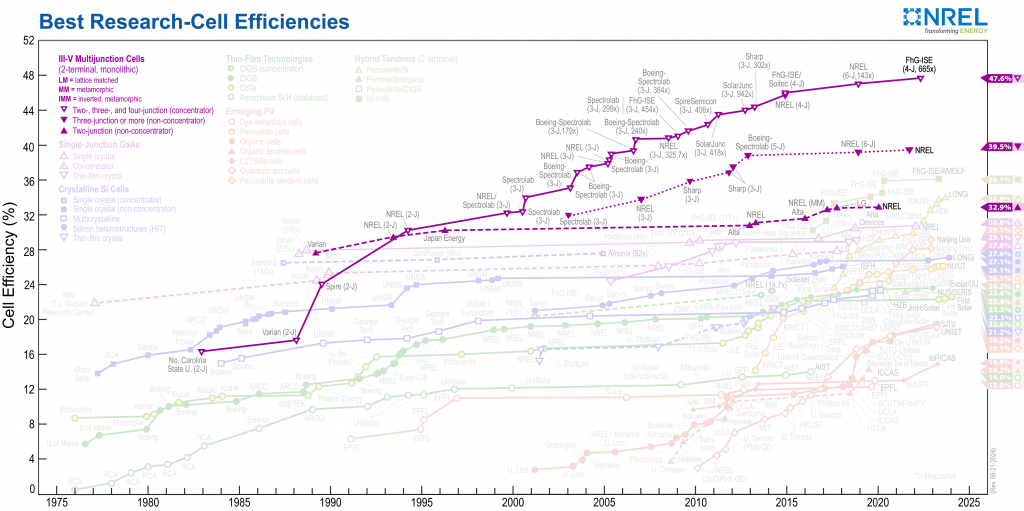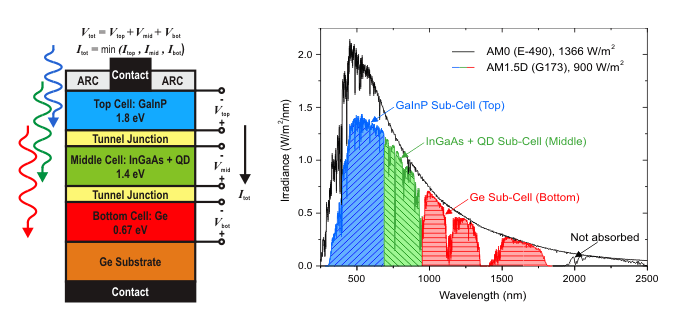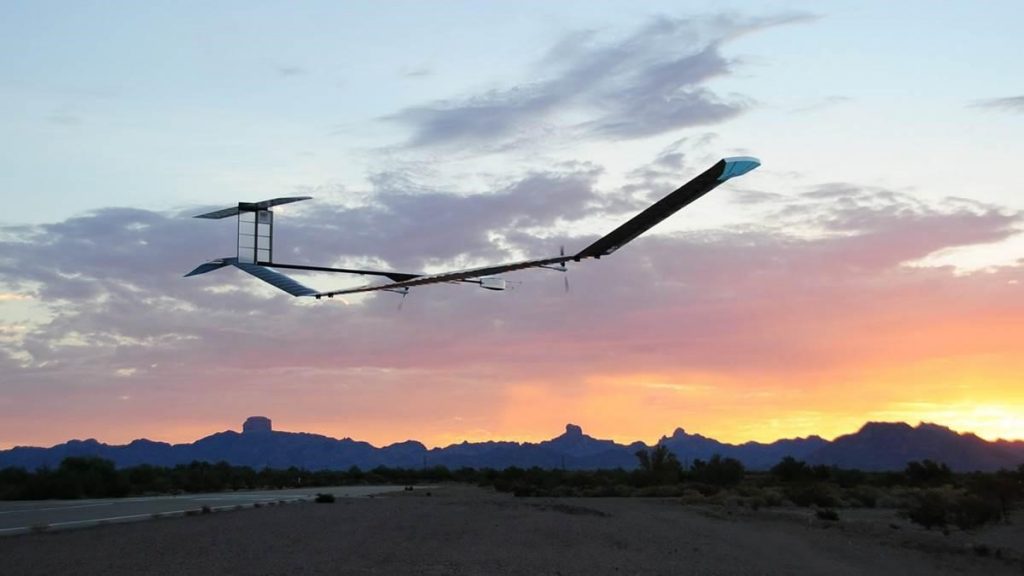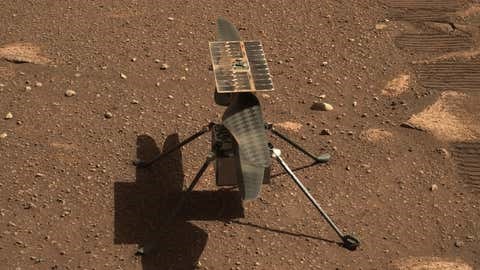Tandem Solar Cell
Tandem solar cells, also known as multijunction solar cells, are a type of photovoltaic cell that can capture a broader spectrum of sunlight than traditional single-junction solar cells. Consisting of multiple photovoltaic layers with different bandgaps, each designed to absorb different wavelengths of light, tandem solar cells have a broader spectrum. Because tandem solar cells absorb a wider range of the solar spectrum than traditional solar panels, they can generate more electricity from the same surface area. This increased efficiency makes them a good option for harnessing solar energy, especially in applications where space is limited or high efficiency is critical.

Figure 1. NREL solar cell efficiency chart
To meet the growing demand for renewable energy, research continues improving tandem solar cell efficiency. Tandem solar cells can achieve efficiencies exceeding 30%, significantly higher than traditional Si solar cells. This makes them ideal for various uses in space applications.
Tandem Solar Cell Structure

Figure 2. Spectral Variations of Layers in a Three P-N Junction Tandem Solar Cell
Generally, the preferred approach is to stack solar cells in thin-film layers, creating a multi-junction solar cell by combining junctions with different energy gaps. These cells are constructed by combining multiple p-n junctions. These cells are stacked in layers to increase light absorption efficiency. The top layer absorbs blue light, while the bottom layers absorb green and red light, respectively. This allows all wavelengths of sunlight to be efficiently used for energy production.
Tandem Solar Cell Operating Principle
Each p-n junction within the tandem is designed to absorb radiation within a specific wavelength range, reducing loss wavelengths, thus increasing efficiency. This has demonstrated that very high theoretical efficiencies, which seem nearly impossible to achieve with a single solar cell, can also be achieved in practice.
For optimal efficiency in solar cells, the goal is to absorb as much of the solar spectrum as possible. Therefore, the band gaps of the cells comprising the multi-junction structure are desired to cover this wide spectrum. Assuming a tandem solar cell is a three-junction solar cell, the middle junction absorbs lower-energy photons that pass unabsorbed through the preceding junction. This is because this junction, with its higher energy gap, is transparent to photons with lower energy than the band gap. The same process applies to the bottom junction. Furthermore, the middle junction reflects light from its two surfaces or collects light reflected from the other junctions. This photon recovery results in increased efficiency.
Tandem solar cells utilize multiple layers to increase their efficiency. The upper cell is made of a wide-bandgap material that absorbs high-energy light. This layer transmits lower-energy light to the lower cell. The lower cell has a narrower bandgap and absorbs the remaining light. This design allows tandem solar cells to capture a broader spectrum of sunlight and convert more energy into electricity compared to single-junction cells.
Advantages of Tandem Solar Cells
Tandem solar cells can produce more power than single-layer cells. This is achieved by combining different semiconductor materials. This allows them to utilize a wider portion of the solar spectrum, increasing energy production efficiency, reducing power loss, and making them more efficient.
- Higher efficiency and power output
Tandem solar cells are highly effective at generating energy efficiently. By stacking several layers on top of each other, each layer focuses on absorbing a different portion of sunlight. This allows them to convert more than 30% of sunlight into electricity. They offer a highly effective solution in applications with space or weight constraints.
- Low thermal and conduction losses
One of the biggest problems with conventional solar cells is power loss due to heat or light loss. In tandem cells, materials are carefully selected to overcome these problems. This way, more solar energy is converted into electricity, minimizing losses.
- Materials and Design Used
The production of tandem solar cells requires careful planning. Materials that work together to maximize efficiency are carefully selected and designed with the goal of optimally converting sunlight into electricity.
Application Areas
Tandem solar cells are a preferred technology, particularly in sectors requiring high efficiency and durability. The applications of these cells have diversified to address the need for more efficient energy production and long-term performance. Here are some of these areas:
- Aerospace and Military Applications

Figure 3. Airbus Zephyr (unmanned aerial vehicle using solar cells)
Flexible solar cells are used in unmanned aerial vehicles (UAVs), which can remain airborne for extended periods at high altitudes. These cells allow UAVs to remain airborne for days or even months. This avoids expensive operations such as traditional satellite launches. UAVs are used in missions such as mapping, surveillance, border patrol, and search and rescue. In the civilian arena, they are also preferred for flying telephone towers and communication systems. Companies such as Alta Devices, Micro link Devices, and Sol Aero Technologies are leading manufacturers in this field.
- Concentrated Photovoltaic Systems

Figure 4. Fresnel lens that focuses light on a single point
GaAs and multilayer solar cells can increase efficiency by concentrating on sunlight at a single point. Such systems are used to generate more energy in areas with low light intensity. Concentrated photovoltaic systems (CPV) are particularly high-performance in space missions. Designs such as Fresnel lenses and parabolic mirrors allow for the efficient collection of sunlight. These technologies allow for the conversion of sunlight into much more energy.
Probes, Satellites, and Spacecraft

Figure 5. Ingenuity helicopter on Mars (with multi-junction solar cells on top)
Tandem solar cells are indispensable for satellites and spacecrafts used in space. GaAs-based cells are highly resistant to the harsh conditions encountered in space, such as being resistant to gamma rays. Therefore, many spacecrafts, from early space missions like the Venera program to the Hubble Telescope, are equipped with these cells. Finally, as part of the Mars 2020 mission, the Ingenuity helicopter and the Perseverance rover are powered by tandem GaAs cells. These cells offer high efficiency even in Martian conditions, providing safe and long-term energy sources for space exploration.
These applications highlight the superior efficiency, durability, and flexibility of tandem solar cells. This makes them effectively used in high-performance applications, particularly in space technologies and aircraft.
CUNAM’s Projects
CUNAM and METU-GUNAM jointly launched R&D studies on tandem solar cells for the first time in Turkey in 2010 as part of the TUBITAK-1001 project. The studies concluded that large-area silicon-based solar panels, which occupy large areas, cannot be used in military applications and especially in space exploration. These applications necessitate the production of small-area solar cells that can withstand harsh natural conditions and space radiation. It was concluded that tandem solar cells are structured to withstand high temperatures, and that by adding light concentrators, they can both reduce their area and generate energy more efficiently.
Resources
https://blog.feniceenergy.com/tandem-solar-cells-what-they-are-and-how-they-work/
https://www.slideshare.net/slideshow/solar-energy-19030766/19030766